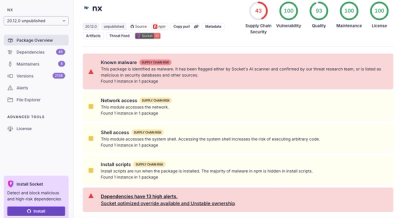
Security News
Nx npm Packages Compromised in Supply Chain Attack Weaponizing AI CLI Tools
Malicious Nx npm versions stole secrets and wallet info using AI CLI tools; Socket’s AI scanner detected the supply chain attack and flagged the malware.
Collector is an implementation of the Repository Pattern for MongoDB. For those new to the Repository Pattern, it is a Facade that isolates the persistence layer from your application. If you're familiar with Rails, or more specifically ActiveRecord or most other ORMs, you'll know that the models and persistence layer are tightly coupled—literally they are the same object. That pattern is a great way to cut your teeth, but ultimately it's a terrible design. Your application does not and should not care about how its data is persisted. Collector will help with that.
Collector is currently under initial development, and I mean that in the context of semantic versioning, which I follow. Initial development is anything with a major version of zero (0.x.x), which means anything may change at any time; there is no public API. I'll do my best not to wildly change anything, but if you upgrade, run your application tests to see if anything breaks. If you don't have application tests then you have failed. Go home and re-think your life choices that have brought you to this point.
Add this line to your application's Gemfile:
gem "collector"
And then execute:
$ bundle install
Or install it yourself as:
$ gem install collector
Set up a connection.
Collector.connection = Mongo::Connection.new
Include Collector::Model in your domain objects to turn them into models. Create accessors for any attributes. Accessors for id, created_at, and updated_at are created automatically.
class Pickle
include Collector::Model
attr_accessor :brine, :started_at
end
Models can be instantiated with a hash of attributes.
Pickle.new(brine: "vinegar", started_at: Time.now)
Models automatically create and update timestamps for created_at and updated_at.
Include Collector::Repository in an object to turn it into a repository for a model of the same name. Use the same inflection as your model's name (singular).
class PickleRepository
include Collector::Repository
end
Repositories can save models.
pickle = Pickle.new(brine: "vinegar", started_at: Time.now)
PickleRepository.save(pickle)
Repositories can find all models, find by id, find dynamically by any attribute, and then find first by id or any other attribute.
PickleRepository.all
PickleRepository.find_by_id(BSON::ObjectId("50af1f3fb392d4aa0d000001"))
PickleRepository.find_by_color("green")
PickleRepository.find_by_taste("delicious")
PickleRepository.find_first_by_id(BSON::ObjectId("50af1f3fb392d4aa0d000001"))
PickleRepository.find_first_by_color("green")
PickleRepository.find_first_by_taste("delicious")
Repositories can delete models.
pickle = Pickle.new(brine: "vinegar", started_at: Time.now)
PickleRepository.save(pickle)
PickleRepository.delete(pickle)
Collector will only work with 1.9.x and above. Specifically it's tested with 1.9.2 and 1.9.3.
Currently only MongoDB. I'd like to add an in-memory store, and if possible, a file store and Redis store.
If you don't already know why you need or want the Repository Pattern, then don't use it yet. It took me far longer than it should have to realize the benefits, despite having them explained to me many times. I just never really understood them until I'd actually experienced the pain this pattern solves myself. Once you do, come back and try it out.
I rolled my own application-specific version of the Repository Pattern for each project I worked on before I realized I was using it often enough to merit extracting it into a gem. Right about that time Braintree announced curator, and since both their implentation and mine were very similar—except theirs was further along and had more features—I decided to use theirs instead. But after using it for a few months and then reading through the code to try and contribute back to it, I decided to go back to my own implementation and extract it into a gem after all.
The specific, functional differences are:
<tr>
<td>curator</td>
<td>MongoDB, Riak, In-memory</td>
<td>RSpec</td>
<td>1.9.x, 1.8.7</td>
</tr>
| Project | Stores | Test suite | Ruby version(s) |
| collector | MongoDB | MiniTest | 1.9.x |
git checkout -b my-new-feature)git commit -am 'Add some feature')git push origin my-new-feature)FAQs
Unknown package
We found that collector demonstrated a not healthy version release cadence and project activity because the last version was released a year ago. It has 1 open source maintainer collaborating on the project.
Did you know?

Socket for GitHub automatically highlights issues in each pull request and monitors the health of all your open source dependencies. Discover the contents of your packages and block harmful activity before you install or update your dependencies.

Security News
Malicious Nx npm versions stole secrets and wallet info using AI CLI tools; Socket’s AI scanner detected the supply chain attack and flagged the malware.

Security News
CISA’s 2025 draft SBOM guidance adds new fields like hashes, licenses, and tool metadata to make software inventories more actionable.

Security News
A clarification on our recent research investigating 60 malicious Ruby gems.